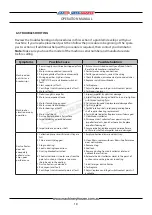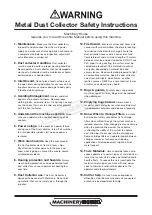
Metal Dust Collector Safety Instructions
1. Maintenance.
Make sure the Dust collector is
turned off and disconnect from the main power
supply and make sure all moving parts have come to
a complete stop before any inspection, adjustment
or maintenance is carried out.
2. Dust collector Condition.
Dust collector
must be maintained for a proper working condition.
Never operate a Dust collector that has damaged or
worn parts. Scheduled routine maintenance should
performed on a scheduled basis.
3. Inlet Hazard.
Do not place hands or tools near
the open inlets during operation for any reason. The
impeller could cause serious damage to body parts
if touched while spinning.
4. Avoiding Entanglement.
Guards and dust
bags must be used at all times. Remove loose
clothing, belts, or jewelry items. Tie up long hair and
use the correct hair nets to avoid any entanglement
with the Dust collector.
5. Understand the machines controls.
Make
sure you understand the use and operation of all
controls.
6. Power outage.
In the event of a power failure
during use of the Dust collector, turn off all switches
to avoid possible sudden start up once power is
restored.
7. Work area hazards.
Keep the area around
the Dust collector clean from oil, tools, chips.
Pay attention to other persons in the area and
know what is going on around the area to ensure
unintended accidents.
8. Hearing protection and hazards.
Always
wear hearing protection as noise generated from
dust collector can cause permanent hearing loss
over time.
9. Dust Collector use.
This Dust Collector is
designed to be used with Metal only. Do not pick
up material that can not safety pass through the
impeller.
10. Fire Hazard.
Ensure machines and hoses only
connect with smooth-walled, sheet-metal ducting,
to minimize static electrical charge. Ensure the
dust extraction hose used is heat resistant and
flame retardant and a minimum length of 2 meters
between machine and dust collector. DO NOT use
PVC pipe. If using ducting, the system must be
sealed and grounded. Fine metal dust particles
can ignite, depending on material type and
circumstances. Be educated and prepared to fight
a combustible metal fire. Keep the dust collector
away from pilot lights, open flames, or other
ignition sources. NEVER use near chemical fumes
or within an enclosed spray booth.
11. Bags & guards.
All safety bags and guards
must be used at all times. Bags must be replaced
when damaged.
12. Emptying bags hazard.
Always wear a
respirator and safety glasses when emptying dust
into approved containers and dispose of properly.
13. Know When to Change Filters.
A simple
but important safety requirement is to change
filters when airflow through the system reaches a
reduced pressure. Filter changing is also necessary
when the pressure drop across the collector
is affecting the ability of the system to capture
dust, allowing it to escape into the atmosphere.
Some cartridge filters can operate longer between
changes. However, for heavy dust-loading
applications, filter replacement might be much
more frequent.
14. Toxic Materials.
Care should be taken not to
expose operators to certain types of metal dusts or
fumes that can result in serious, potentially deadly
health effects. To reduce this risk, investigate the
toxicity of metal types you work with and always
seek to minimize or eliminate exposure to the
operator and other bystanders.
15. Call for help.
If at any time you experience
difficulties, stop the machine and call you nearest
branch service department for help.
Machinery House
requires you to read this entire Manual before using this machine.





























